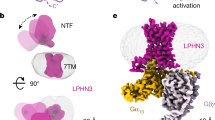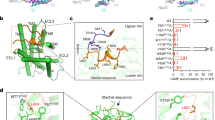Abstract
The structure in solution of the second Ig-module fragment of residues 117–208 of NCAM has been determined. Like the first Ig-module of residues 20–116, it belongs to the I set of the immunogloblin superfamily. Module 1 and module 2 interact weakly, and the binding sites of this interaction have been identified. The two–module fragment NCAM(20–208) is a stable dimer. Removal of the charged residues in these sites in NCAM(20–208) abolishes the dimerization. Modeling the dimer of NCAM(20–208) to fit the interactions of these charges produces one coherent binding site for the formation of two antiparallel strands of the first two NCAM modules. This mode of binding could be a major element in trans–cellular interactions in neural cell adhesion.
This is a preview of subscription content, access via your institution
Access options
Subscribe to this journal
Receive 12 print issues and online access
$189.00 per year
only $15.75 per issue
Buy this article
- Purchase on Springer Link
- Instant access to full article PDF
Prices may be subject to local taxes which are calculated during checkout







Similar content being viewed by others
Accession codes
References
Wagner, G. & Wyss, F. Cell surface adhesion receptors. Curr. Opin. Struct. Biol. 4, 841–851 (1994).
Cremer, H. et al. Inactivation of the N-CAM gene in mice results in size reduction of the olfactory bulb and deficits in spatial learning. Nature 367, 455–459 ( 1994).
Cunningham, B.A. et al. Neural cell adhesion molecule: structure, immunoglobulin-like domains, cell surface modulation, and alternative RNA splicing. Science 236, 799–806 ( 1987).
Noble, M. et al. Glial cells express N-CAM/D2-CAM-like polypeptides in vitro. Nature 316, 725–728 (1985).
Edelman, G.M. & Crossin, K.L. Cell adhesion molecules: implication for a molecular histology. Annu. Rev. Biochem. 60, 155–190 (1991).
Moran, N. & Bock, E. Characterization of the kinetics of neural cell adhesion molecule homophilic binding. FEBS Lett. 242, 121–124 (1988).
Ranheim, T.S., Edelman, G.M. & Cunningham, B.A. Homophilic binding mediated by the neural cell adhesion molecule involves multiple immunoglobulin domains. Proc. Natl. Acad. Sci. USA 93, 4071–4075 (1996).
Rao, Y., Wu, X.-F., Gariepy, J., Rutishauser, U. & Siu, C.-H. Identification of a peptide sequence involved in homophilic binding in the neural cell adhesion molecule NCAM. J. Cell Biol. 118, 937–949 (1992).
Rao, Y., Wu, X.-F., Yip, P., Gariepy, J. & Siu, C.-H. Structural characterization of a homophilic binding site in the neural cell adhesion molecule. J. Biol. Chem. 268, 20630–20638 (1993).
Rao, Y., Zhao, X. & Siu, C.-H. Mechanism of homophilic binding mediated by the neural cell adhesion molecule NCAM. J. Mol. Biol. 269, 27540–27548 (1994).
Sandig, M., Rao, Y. & Siu, C.-H. The homophilic binding site of the neural cell adhesion molecule NCAM is directly involved in promoting neurite outgrowth from cultured neural retinal cells. J. Biol. Chem. 269, 14841– 14848 (1994).
Kiselyov, V.K. et al. The first immunoglobulin-like neural cell adhesion molecule (NCAM) domain is involved in double-reciprocal interaction with the second immunoglobulin-like NCAM domain and in heparin binding. J. Biol. Chem. 272, 10125–10134 ( 1997).
Becker, J.W., Erickson, H.P., Hoffman, S., Cunningham, B.A. & Edelman, G.M. Topology of cell adhesion molecules. Proc. Natl. Acad. Sci. USA 86, 1088 – 1092 (1989).
Frei, T., von Bohlen und Halbach, F., Wille, W. & Schachner, M. Different extracellular domains of the neural cell adhesion molecule (NCAM) are involved in different functions. J. Cell Biol. 118, 177–194 (1992).
Harpaz, Y. & Chothia, C. Many of the immunoglobulin superfamily domains in cell adhesion molecules and surface receptors belong to a new structural set which is close to that containing variable domains. J. Mol. Biol. 238, 528–539 ( 1994).
Hoffman, S. & Edelman, G.M. Kinetics of homophilic binding by embryonic and adult forms of the neural cell adhesion molecule. Proc. Natl. Acad. Sci. USA 80, 5762– 5766 (1983).
Baldwin, T.J., Fazli, M.S., Doherty, P. & Walsh, F.S. Elucidation of molecular actions of NCAM and structurally related adhesion molecules. J. Cell Biochem. 61, 501–513 (1994).
Thomsen, N.K. et al. The three-dimensional structure of the first domain of neural cell adhesion molecule. Nature Struct. Biol. 3, 581–585 (1996).
Chothia, C. & Jones, E.Y. The molecular structure of cell adhesion molecules. Annu. Rev. Biochem. 66, 823–862 (1997).
Bodenhausen, G. & Ruben, D.J. Natural abundance nitrogen-15 NMR by enhanced heteronuclear spectroscopy. Chem. Phys. Lett. 69, 185–189 ( 1980).
Meissner, A., Schulte-Herbrüggen, T., Briand, J. & Sørensen, O.W. Double spin-state-selective coherence transfer. Application for two-dimensional selection of multiplet components with long transverse relaxation times. Molecular Physics 95, 1137–1142 (1998).
Brünger, A.T. X-PLOR version 3.1: A system for X-ray crystallography and NMR (Yale University, New Haven Connecticut; 1992).
Braunsweiler, L. & Ernst, R.R. Coherence transfer by isotropic mixing: application to proton correlation spectroscopy. J. Magn. Reson. 53, 521–528 (1983).
Kumar, A., Wagner, G., Ernst, R.R. & Wüthrich, K. Buildup rates of the nuclear Overhauser effect measured by two-dimensional proton magnetic resonance spectroscopy: implications for studies of protein conformation. J. Am. Chem. Soc. 103, 3654 – 3658 (1981).
Piantini, U., Sørensen, O.W. & Ernst, R.R. Multiple quantum filters for elucidating NMR coupling networks. J. Am. Chem. Soc. 104, 6800– 6801 (1982).
Zhang, O., Kay, L.E., Olivier, J.P. & Forman-Kay, J.D. Backbone 1H and 15N resonance assignments of the N-terminal SH3 domain of drk in folded and unfolded states using enhanced-sensitivity pulsed field gradient NMR techniques. J. Biomol. NMR. 4, 845–858 (1994).
Kjær, M., Andersen, M.K. & Poulsen, F.M. Automated and semiautomated analysis of homo- and heteronuclear multidimensional nuclear magnetic resonance spectra of proteins: the program Pronto. Methods Enzymol. 239, 288–307 (1994).
Nicholls, A. GRASP: graphical representation and analysis of surface properties. (Columbia University Press, New York, NY; 1993).
Acknowledgements
The group at the Protein Laboratory was supported by the Danish Biotechnology Programme, The Lundbeck Foundation, the Danish Cancer Society, and The EU programme on Biotechnology. The group at the Carlsberg Laboratory was supported by The Danish Biotechnology Programme. This is a contribution from the Danish Instrument Center for NMR spectroscopy of Biological Macromolecules.
Author information
Authors and Affiliations
Corresponding author
Rights and permissions
About this article
Cite this article
Jensen, P., Soroka, V., Thomsen, N. et al. Structure and interactions of NCAM modules 1 and 2, basic elements in neural cell adhesion. Nat Struct Mol Biol 6, 486–493 (1999). https://doi.org/10.1038/8292
Received:
Accepted:
Issue Date:
DOI: https://doi.org/10.1038/8292
This article is cited by
-
Intercellular protein–protein interactions at synapses
Protein & Cell (2014)
-
Special Issue Dedicated to Elisabeth Bock
Neurochemical Research (2013)



